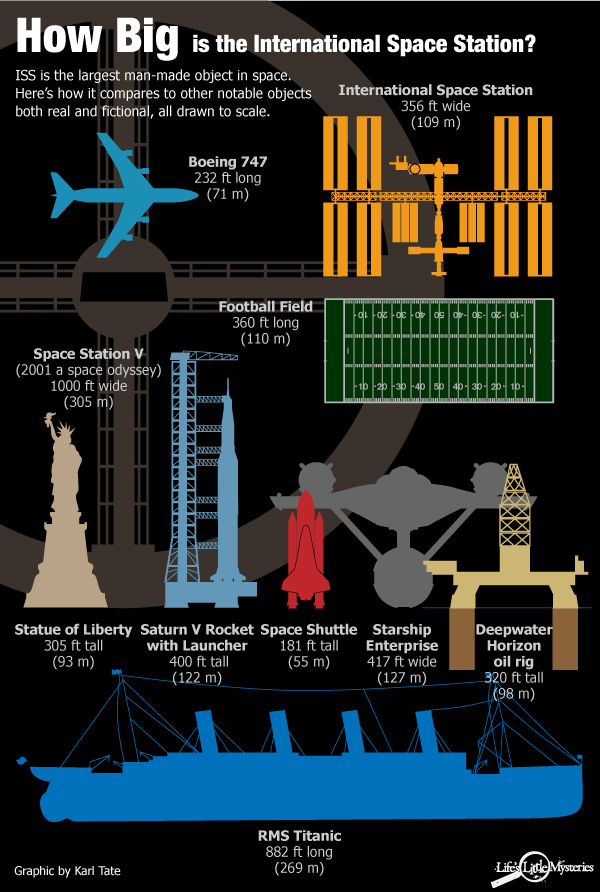How Big Is the International Space Station?
Essentially a laboratory that orbits Earth, the International Space Station (ISS) is now 98 percent complete, and the countdown is underway for the liftoff of space shuttle Atlantis as it prepares to deliver a new science module to the ISS. Scheduled to launch on Friday, May 14 at 2:20 p.m. EST, this mission will be Atlantis' last, and will put some of the finishing touches on the ISS. [Read More Below]

The largest spacecraft ever built, the ISS is also the world's most expensive single object, costing upwards of 100 billion dollars, according to the Government Accountability Office.
The dimensions of the completed ISS research facility will be approximately 356 feet (109 meters) by 240 feet (73 meters), or slightly larger than a football field. When completed, the ISS will weigh around 450 tons (408,000 kg), or 450 times the weight of an average car.
The ISS is so large that it is visible to the naked eye from the ground. It may be easiest to see after the sun has set, but its fading rays are still able to reach the space station's reflective surface. It circles the Earth every 90 minutes, traveling at 4.8 miles (7.7 km) per second, flying in one of the lowest orbits possible at approximately 242 miles (390 km) above Earth.
Construction of the space station began in 1998 and the ISS was expected to be finished by 2003, but delays and cancellations caused the completion date to be pushed to late 2011.
The new chamber that Atlantis will deliver contains a Russian-built mini-research module, a cargo carrier and additional batteries. The chamber weighs more than 18,000 pounds (8,200 kg), and contains 3,000 pounds (1400 kg) of equipment, food, water, fuel and spare parts.
"Twelve days, three [spacewalks], tons of robotics...We're putting on spares that make us feel good about the long-term sustainability of the ISS, replacing batteries that have been up there for a while, and docking a Russian-built ISS module," said space shuttle program manager John Shannon in a NASA statement.
Sign up for the Live Science daily newsletter now
Get the world’s most fascinating discoveries delivered straight to your inbox.
The space station is permanently inhabited, with a crew of six people currently calling it home, including a Canadian astronaut who previously served as a medical officer onboard a submarine and a Belgian spaceflyer who was formerly an army general.
Within the ISS is a laboratory in which scientists conduct daily experiments, including studies on the effects of long-term space exposure on the human body. Plants are grown in the greenhouses of the station's laboratory to study their development in low gravity settings. There is also a gym, a sleep station and a robotic workstation.
The ISS gets its energy by converting sunlight into electricity using solar arrays, and relies on rechargeable nickel-hydrogen batteries during the 35 minutes of each orbit that the station is eclipsed by the Earth.
Last year, NASA space station program manager Michael T. Suffredini announced that the ISS is scheduled to be taken out of orbit and steered toward the Pacific Ocean because it will become a giant fireball when it enters our atmosphere. The de-orbiting is planned to take place in early 2016, as there is currently no long-term funding for ISS operations past 2015.
Heralded as the greatest international project of all time by the European Space Agency, the ISS is a cooperative program between the United States, Europe, Russia, Canada, and Japan.









